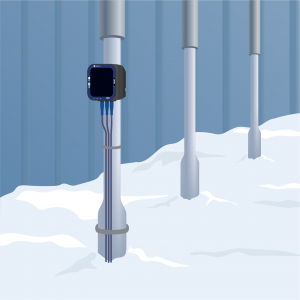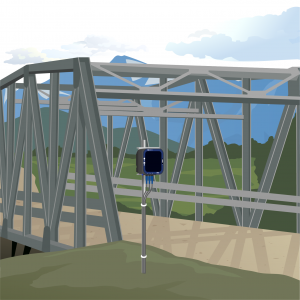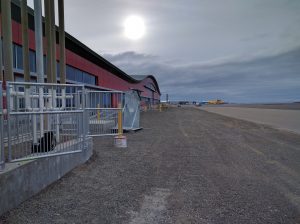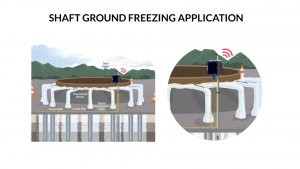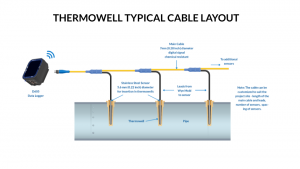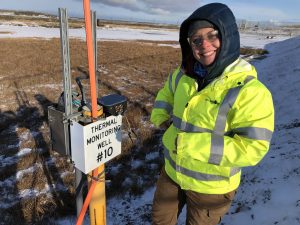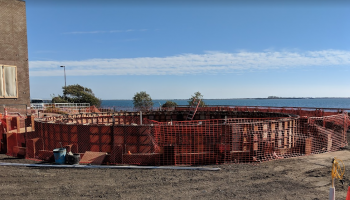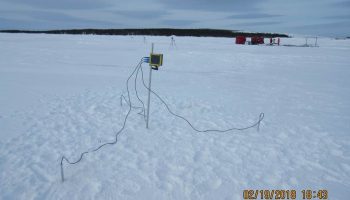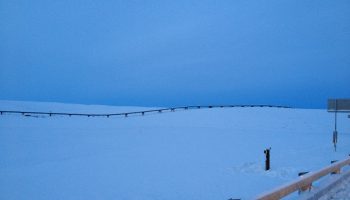Infrastructure
Temperature monitoring solutions for the Infrastructure industry
Infrastructure
The Infrastructure market covers a broad range of applications that can be found in different climatic regions. Cold region engineering includes assets built on permafrost in the arctic or antarctic regions of the world. For warmer regions, temperature monitoring can help engineers understand subsurface conditions that may impact performance of the structure. Infrastructure applications include:
Foundations & Pilings
Buildings and other structures built on permafrost disturb the natural ground surface and can introduce heat into the ground, increasing the risk of permafrost thaw over that which is naturally occurring as the climate warms. When this occurs, the structures can be subject to ground slumps or differential settlement, both of which can lead to the building being deemed to be structurally unsafe. The foundation of new structures aim to be deeper than the active layer of the permafrost (i.e. using piles) or utilize methods, such as installing thermosyphons, to keep the ground frozen.
Understanding the ground temperature profile under and around these structures provide early warning signs of permafrost thaw, allowing engineers to implement mitigation efforts before a structure is damaged. Temperature cables are installed vertically into the permafrost under the footprint of the structure and horizontally along ground cooling systems in the foundation, when utilized.
Highways, Roads, Railways & Bridges
Highways, roads and railways in northern climates can be subject to dangerous conditions during winter and subject to weight restrictions during spring thaw. Both of these concerns apply to infrastructure built over permafrost and to infrastructure that is not. Road weather information systems (RWIS) are gaining popularity within government highway organizations as real-time transfer of data becomes easier and more cost effective, even from remote locations. Data collected includes atmospheric conditions and both pavement and shallow ground temperatures. The data is used to assess current conditions and to develop forecasts, allowing departments to warn drivers via Intelligent Warning Signs along affected corridors or to implement mitigation strategies, such as plowing or sanding.
Seasonal road weight restrictions have historically been applied by highways departments based upon prior observations and not on real-time data. Changing climatic conditions mean that historical observations may no longer be representative. Heavy vehicles and commercial transport trucks are affected during these restrictions, resulting in extra costs to their clients due to reduced loads and additional trips. Ground temperature cables, with automated data transfer, installed in strategic locations along a highway network allow for the department to monitor the timing of ground thaw and to enact the restrictions based upon real-time data.
These critical infrastructure corridors, when built upon permafrost, face additional challenges. The construction of these assets in the first place actually disrupts the natural state of the permafrost and can lead to increased thaw and active layer thickness. Permafrost thaw can lead to slumps that can take out full sections of the corridor or freeze/thaw cycles can cause severe differential settlement that requires costly regular maintenance. Frozen debris lobes (a slow-moving landslide in permafrost) become more prevalent as the climate warms. Understanding the ground temperature profile in real-time can aid in identifying problem areas earlier and assessing the impacts of mitigation efforts used to counteract the thaw.
Airports
Airports in Arctic communities often are vital infrastructure for the local residents as many of these remote communities are not readily accessible via other modes of transportation. The airports are a lifeline that allow goods such as food to arrive in the town and for people to travel to medical appointments in other communities, amongst many other usages.
The airport buildings and runways are subject to the same permafrost thaw that other infrastructure in the north is experiencing. Runways have minimal tolerances for ground deformation, as compared to roads and highways, to allow planes to land safely. Air terminals are multi-million dollar infrastructure assets designed to last for decades and to benefit the local community. These assets benefit from real-time monitoring of permafrost temperatures and the operation of passive freezing systems, where installed, to understand how the ground below is impacted by warming temperatures and to allow for maintenance to be conducted as required.
Ground Freezing
Artificial ground freezing has been gaining popularity in construction, including for shafts and safe havens on tunneling projects. Chilled liquid is circulated through vertical pipes in the ground, freezing porewater and creating a freeze bulb around each pipe. The pipes are installed in closely spaced patterns so freeze bulbs can grow and merge together to create a frozen underground wall. Ground freezing can be used for excavation support, especially where traditional methods such as diaphragm walls are not feasible. It also is an effective way of controlling groundwater in excavations.
Ground freezing can take many weeks to build the frozen wall at the target depth. A critical part of the monitoring program is vertical temperature profiling within and around the frozen zone. Temperature cables with dozens of thermistors collect data and allow the project team to model the frozen bulb development. Additionally, sensors are used to monitor temperatures in the fluid lines leaving the cooling plant and returning from the ground, allowing heat transfer to be evaluated. The data is critical to verify that the ground has frozen as designed and to allow construction to proceed safely. The return on investment (ROI) of a real-time monitoring system can be measured against cost reductions gained by shortened construction time, minimizing standby and eliminating unnecessary freeze plant energy consumption.
Landfills
Landfills built in the arctic are often designed assuming that they will freeze and remain frozen forever, containing the waste material contained within them. But the warming climate, especially in the north, is challenging that assumption.
Monitoring temperatures within the foundation and cell berms allows operators to understand the current conditions and to watch for warming trends that may lead to mitigation efforts to ensure the landfill waste is contained.
Landfills built in other climates also benefit from temperature monitoring as it can identify problem areas such as where exothermic reactions elevate the surrounding temperature. These reactions can impact leachate and gas systems so it is important to understand when and where it is occuring. Horizontal cables with many sensors are installed throughout the waste material to observe local trends in temperature.
Related Case Studies
Do you have any questions or are you
interested in a quote?



